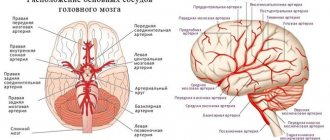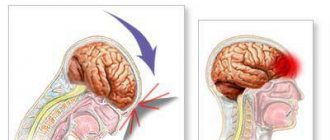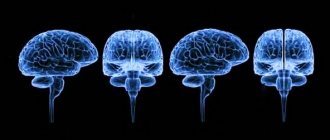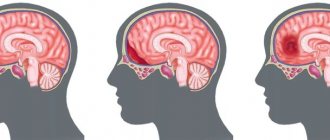Anyone at least once in their life has heard caustic expressions about the convolutions in the head and their relationship with intelligence, but few people know that, contrary to popular belief, a frequent and far from original phrase is that “the number of convolutions in a person’s brain is the same in him.” mind” is completely unfounded. So is the number of brain convolutions an indicator of any characteristics of the human body, and is there a certain “ideal” number of them? Is there any difference between the normal number of grooves in the brain of a woman and a man? This article will provide answers to these questions.
Brain convolutions: what are they and why are they formed
The human brain is the most complex organ. It consists of more than one hundred billion neurons. This is not surprising, because this organ is the main control center that controls all processes in our body; it gives self-awareness, which makes a person a person, an individual.
Retaining all this number of elements in a limited space, the surface of the brain, called the cerebral cortex, is naturally covered with countless grooves. Such anatomy is a consequence of the body’s adaptation to “crowding,” that is, the limited space of the skull.
The mechanism of formation of convolutions can be easily illustrated as follows: it is easier to push a square leaf into a small round box by crumpling it. In this case, the lump into which the once square sheet has turned becomes a set of grooves similar to those found in the brain when the organ is compactly located in the cranium.
Contrary to popular belief, the number of grooves on a person’s gray matter can neither increase nor decrease, regardless of what activity he engages in throughout his life. The structure of the brain, externally similar to the kernels of a walnut, is formed in humans while still in the embryonic state. Thus, the smooth surface of the gray matter begins to be streaked with grooves at the twentieth week of pregnancy, and they cease to appear in the child at the age of one and a half years. That is, from this very time on, the number and position of the folds have been formed completely and for the rest of life, so that talk about the fact that the convolutions can straighten over time is completely unfounded.
Interestingly, the normal weight of a newborn's brain is about 0.3 kg - this is about 1/8 of his total body weight. In a mature healthy person, the weight of the brain organ should increase five times with an average area of 2200 cm2.
How many brains do you have to have to be smart?
A student and colleague of the founder of the Institute of the Human Brain, academician Natalya Bekhtereva, Doctor of Medical Sciences Alla SHANDURINA told Online812 about what she likes about the human brain and dispelled the legend about two convolutions
– The brain has been studied for a long time. This is a final process - when will we know everything? – You know, it’s very paradoxical: studying the brain with the brain.
– Isn’t it strange to study other parts of the body? - Of course not. There is nothing strange in studying the body with the brain, but there is nothing strange in the brain with the brain. My point of view today: the brain will not be fully studied by the brain.
– How can we study it then? – By intuition. – But you yourself often said that all your discoveries are from God. – Intuition is also from God. So do insights.
– Great scientists are often materialists. – It is young scientists who are materialists. Those who are wiser, such as Natalya Bekhtereva, understood that the brain was given for processing information.
– But they understood this with their brains? - Soul.
– They say that a person’s soul is in the brain? - She is not there. She is not material. Although the brain and soul are somewhere nearby all the time. Yes, they are close, but they do not coincide.
– When did you decide to study the brain? - From the first year. I was interested in everything - what convolutions, tubercles, grooves were in it.
– Did you know then what you would do after graduation – practicing medicine or science? - I knew. Only science. In my third year, I joined the student scientific society of pathophysiology, but only in my fourth year did I get to the human brain, not by dissection, but by studying reflexes and psychological tests.
– What did you think when you first saw the human brain? - About how wonderful he is, how handsome he is.
- And what is its beauty? - There are so many convolutions in it. He is as beautiful as a walnut.
– You tell such a delicious story. - Chicken brains are definitely delicious.
- Yah. -Have you never eaten chicken brains? They are very healthy, they have a lot of cholesterol, and cholesterol is good for you. Our brain consists mainly of it. Why should it be limited? What will the brain feed on?
– What about all this talk about the dangers of cholesterol? – It can be different – heavy and light. Light is generally necessary; it contains a set of essential amino acids. There is the highest amount of heavy cholesterol in lamb; it is the most difficult to digest food, although the lamb eats pure organic food, unlike the pig. Someone came up with the stupid idea that eggs are bad for you because of cholesterol. The famous Nikolai Nikolaevich Anikov. He did experiments on rabbits. As you know, they do not have enzymes for processing proteins because they feed on grass. Humans have these enzymes, which is why they are omnivores. Therefore, all this separate nutrition, dry eating seems nonsense. In general, do you know what Academician Pavlov said about why dinner is arranged the way it is – first, second, third and salad? First, you definitely need fifty grams of vodka. Pavlov did not encourage drunkenness. Fifty grams of vodka promotes the secretion of gastric juice; in most people it is not secreted enough. You can eat the salad or not, but the former is mandatory, because the broth also promotes the secretion of gastric juice. The second is needed to get enough. Then sweets. Pavlov said that it is needed to pamper the taste buds and inhibit the secretion of gastric juice. Everything is very reasonable.
– Can we say that the brain is the most unexplored thing in a person? - Perhaps, yes. Endocrine functions are more studied.
– Have you ever seen the brain of Lenin or Mayakovsky? – They are at the Brain Institute in Moscow. Thank God I didn’t see it. Why do I need to see brains twisted by disease?
– We are all so different, so does that mean we each have our own brain? – To some extent, yes... The weight of the brain and gyri do not matter at all. Functional connections in the brain matter.
– So, the joke about the military having two convolutions is just a joke? – There may be one or two, but a person is smarter the more connections there are between them. Of course, I’m exaggerating a little, but a person can have a lot of convolutions, and he can be an idiot, because functional connections are not formed.
– There is a saying: everything is sorted into shelves in his brain. Is this just an image, or do the “shelves” have a scientific explanation? – At the end of the 19th century, two schools of physiologists studied the functions of the brain. One school believed that in each part of the brain there is some kind of function, for example, love for the homeland, mother, wife, in another place there is conscience, hatred, and all this is sorted into shelves, and each part of the brain has a complex function. Another school believed that the brain was responsible for everything, that is, defects could depend on how much of the brain was affected. The more it is damaged, the more defects there are. The first ones were more right. Much in our brain is sorted into shelves. An interesting example is the bilingualism of Canadians. After birth, they speak two languages - English and French. If a stroke occurs, the person stops speaking one of them. This is a clinically proven fact.
– You have been studying the brain for so many years. Did you see anything divine there? – The Divine does not depend on picking your brain. There was a period when, not entirely scientifically, but correctly, electrodes were implanted into the human brain, they were introduced using special calculations. For example, a person who has some kind of defect, but cannot be treated with conventional methods, or has impaired movement or unbearable pain. There was such a gentle method: to determine which part of the brain was affected, a small hole was made in the skull and electrodes were inserted into the deep parts of the brain. It happened that during this stimulation one of the fingers might begin to move, or he would remember something that he had long forgotten. For example, I could remember a melody that I heard as a child. Thus, the science of localizing brain function was created. This was even before ankylosing spondylitis began to study the brain. So it was determined that there are areas in the brain that are responsible for different functions. But they did not find anything divine in him.
– Did you have to experiment on yourself? – Neither Bekhtereva, nor Smirnov, nor I implanted electrodes into ourselves, of course. But if we talk about stimulation, we practiced something on ourselves - we applied electrodes to our heads. As you can see, I remained alive. I also tested the effects of the medications on myself.
– Weren’t you afraid? – Actually, I am against drugs, I am for herbs. Chemistry is needed only in cases where it is needed. I practically don't take pills. In the first years of my medical practice, we dealt with the problems of Parkinsonism, tested different options for influencing its treatment with medications that could indirectly improve the patient’s condition. Patients were usually given tranquilizers to calm them down. One day I decided to test the effect of an antidepressant on myself, which reduces depression. I then worked at the Institute of Experimental Medicine in the Moscow region. Before leaving work, I took a pill. On the way home to Nauki Avenue, I fell asleep, but that’s not the worst thing - they pushed me. At home I went to bed and slept until the morning. In the morning, getting ready for college, I felt a state of unjustified anxiety, completely unmotivated. In addition, I could not sit in one place for more than five minutes, and I could barely get to work. And this is called an antidepressant medicine?! Would I ever put it in my mouth again and recommend it to someone? No way! Then I had the opportunity to pull out patients who came pumped full of similar pills from mental hospitals. They still stuff patients with these pills. So, I am against medications. But so many of them are now divorced. The craze for medicines continues to grow, the number of pharmacies outnumbers the population, despite the fact that there are television programs about counterfeit medicines. As a result, it turns out that some disease decreases, and another one comes to replace it. Any medicine, even the most expensive one, causes side effects. This is where it’s time for me to attack doctors who prescribe unnecessary drugs to patients. Do you think they don't have a stake in pharmacies?
– Has the human brain changed compared to the 15th or 18th centuries? – It’s the psyche that changes, rather than the brain, and this is broader than the brain. The abilities to love and suffer are related to the brain, but they are more spiritual. They remain largely unchanged. Nowadays you can also find Shakespearean passions, although even under Shakespeare not everyone possessed these passions. Not everyone is capable of them.
– After the release of the series about Wolf Messing, interest in the ability to read other people’s thoughts arose again. Is this also a property of the brain or a special gift? – Of course, this is a property of the brain. There are people who naturally have the ability to put another person into hypnosis. There are only a few such people. There is also psychotherapy, with its help a person can be convinced without any hypnosis. Reading others' thoughts from a distance is contrary to man's ability to survive as a species. This is not only my opinion, but also that of Natalia Petrovna Bekhtereva. If everyone had such abilities, then humanity would no longer exist. Imagine, one is thinking about how to deceive or kill another, and the other is reading his thoughts from a distance. Therefore, God cannot allow people to have such abilities. This is contrary to his creation of man.
– They say that when people love each other, they understand each other perfectly. What to do with this? – They have a common biofield, that’s why they understand each other. When spouses live together for many years, they understand everything because they know each other. This does not mean that they read each other's thoughts. The same Messing could foresee the future, but could not change it. When a person is given the gift of foreseeing the future and at the same time he cannot change anything about it, this is punishment. Messing knew that his wife would die, he knew the day and the minute, but he could not save her. Can you imagine the torment he had? It was the devil who gave him such abilities, apparently for some sins of his ancestors. What god can give a person such abilities? Andrey MOROZOV
Reference
Alla Shandurina. Professor. Doctor of Medical Sciences. Graduated from the 1st Leningrad Medical Institute. After graduate school, she worked as a senior researcher at the Institute of Experimental Medicine of the Academy of Medical Sciences. In the 1970s, she took part in the creation of the clinical and physiological foundations of the method of therapeutic electrical stimulation of deep brain structures. She created a new method for restoring vision using electrical stimulation of the affected optic nerves. She headed the laboratory of the department of restoration of sensory systems at the Brain Institute of the Russian Academy of Sciences. In 1995, she created a scientific and medical center for the restoration of impaired brain functions.
What determines the number of convolutions and is it possible to count them?
According to the latest data obtained in the course of research by Brazilian scientists, the number of convolutions in a person depends on two main variables: the area of the cortex and its thickness. This discovery fits organically into the general theory, because a large area is more difficult to locate in the cranium, and it is also more difficult to form folds in a thick layer of gray matter.
Interestingly, the folds inherent in the human brain are almost not observed in other mammals. The exception is the whale, pig, dog, cat and some primates. A dolphin, for example, has significantly more convolutions than a human.
It is impossible to know exactly the number of grooves, and there is no “absolute” for this parameter. The appearance of the cerebral cortex is individual for everyone, and during an external examination it is not possible to see the total area of its cortex: approximately 2/3 of the gyri are located in deeper grooves.
However, for a person we can name the main convolutions present in the head of everyone:
- toothed;
- tape;
- occipitotemporal;
- lingual;
- parahippocampal;
- straight;
- hook of the brain.
Well, the total number is not at all impressive, but we can say with confidence how many convolutions in the human brain are guaranteed to end up in the same place in anyone’s head.
What it is
The convolutions of the brain are small elevations above its surface, bounded by grooves. These folds are located throughout the entire telencephalon, and their area averages 1200 cm3. The fact that the functional surface increases due to specific folds is indicated by the numbers: most of the cortex (2/3) is located between the folds in the depths of the depressions. There is an explanation for such a phenomenon as the formation of convolutions: during intrauterine development, the baby’s brain develops unevenly in different places, and, as a result, the tension of the surfaces in different parts is different.
The sulci of the brain are peculiar grooves that separate the convolutions from each other. These formations are classified: primary, secondary and tertiary. The first type of depressions are formed very first in the process of fetal formation. Secondary grooves appear later and are permanent. Tertiary grooves are variable: grooves can change their shape, direction and even size. These depressions divide the surface of the cerebral hemispheres into main lobes: parietal, temporal, frontal, insular and occipital.
Does the number of convolutions affect the level of intelligence?
Today it has been scientifically proven that the number of convolutions, as well as the mass of the brain, cannot in any way affect the mental development of a person. And even if you read the works of ancient Greek philosophers from morning to night, you will not gain as many gyri as you do grams of weight. This is logical, because the human convolutions in the form in which they remain throughout life are formed during the period of intrauterine development, and the weight of the brain depends on the body composition.
Some scientists and ordinary citizens who donate their bodies to science after death have allowed repeated studies to be conducted that have established that physiological differences between the brains of ordinary people and scientists do not correlate with the intelligence demonstrated during life.
Occipital lobe
The boundaries of the occipital region of the brain are outlined by the following formations: it is separated from the parietal lobe by the parieto-occipital recess, from below the occipital part smoothly flows into the basal surface of the brain.
It is in this area of the brain that the most unstable structures are located. But the posterior occipital gyrus of the brain is present in almost all individuals. Moving closer to the parietal region, transitional gyri are formed from it.
On the inner surface of this area there is a calcarine groove. It separates three convolutions from each other:
- wedge;
- lingular gyrus;
- occipitotemporal gyrus.
There are also polar grooves that have a vertical direction.
The function of the most posterior lobe of the brain is the perception and processing of visual information. It is noteworthy that the projection of the upper half of the retina of the eyeball is in the wedge, but it perceives the lower part of the visual field. And the lower half of the retina, which receives light from the upper visual field, is projected in the region of the lingual gyrus.
Is there a connection between a person's gender and the number of convolutions?
The long-known fact that the male brain weighs more than the female brain has given rise to many ridiculous jokes and stereotypes. However, a worthy answer to the jokers was given by scientists who found that the female brain, as opposed to the male brain, has a more complex structure with a significantly larger number of convolutions, which compensates for less weight. For the same reason, neurons in men's heads are located at a greater distance. Thus, the area of the human brain, regardless of the gender of its owner, is equal.
Studies have found that the gray matter content in men's heads is 20% less. In accordance with this, the difference in the number of convolutions or the mass of the brain does not give a single advantage to the genders: in the level of intelligence, both sexes do not differ.
The human brain is the largest element of the central nervous system, which determines the complexity of its structure. It is he who makes a person himself, gives him the miracle of consciousness. Naturally, scientists have long been interested in whether there is a connection between the appearance of the brain and the kind of personality it makes its owner. For now, we can say for sure: neither its mass, nor how many convolutions a person has in the brain, defines an individual as smart or stupid. The grooves in the gray matter are just folds of a huge organ squeezed into the human skull. Attempts to calculate their average number are pointless, because for each person this number is individual, and in structure and appearance they can be both deep and barely visible to the eye, which makes the counting process impossible.
Parts of the brain
During intrauterine development, a complex brain was formed from an ordinary neural tube. This happened due to the bulging of five brain vesicles, which gave rise to the corresponding parts of the brain:
- telencephalon, or forebrain, from which the cerebral cortex, basal ganglia, and anterior part of the hypothalamus were formed;
- diencephalon, or diencephalon, which gave rise to the thalamus, epithalamus, and posterior part of the hypothalamus;
- mesencephalon, or midbrain, from which the quadrigeminal peduncle and cerebral peduncles subsequently formed;
- the metencephalon, or hindbrain, which gave rise to the cerebellum and pons;
- myelencephalon, or medulla oblongata.
Later in the article we will talk in more detail about the telencephalon, or forebrain. After all, the relief of the cerebral cortex belongs specifically to this part of the central nervous system.








